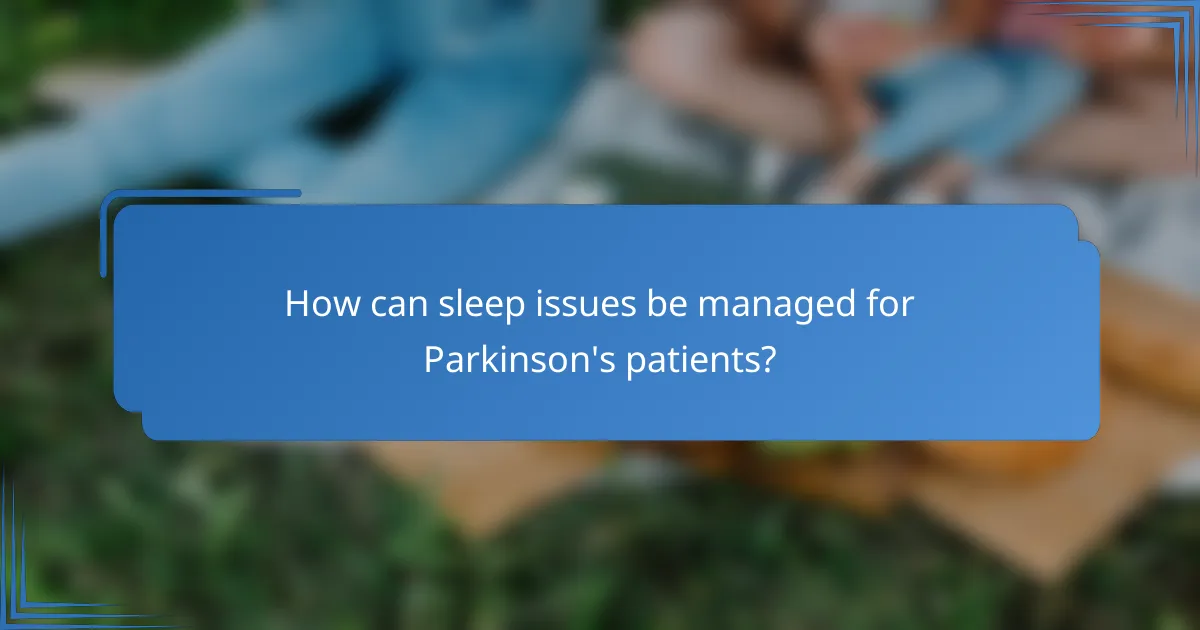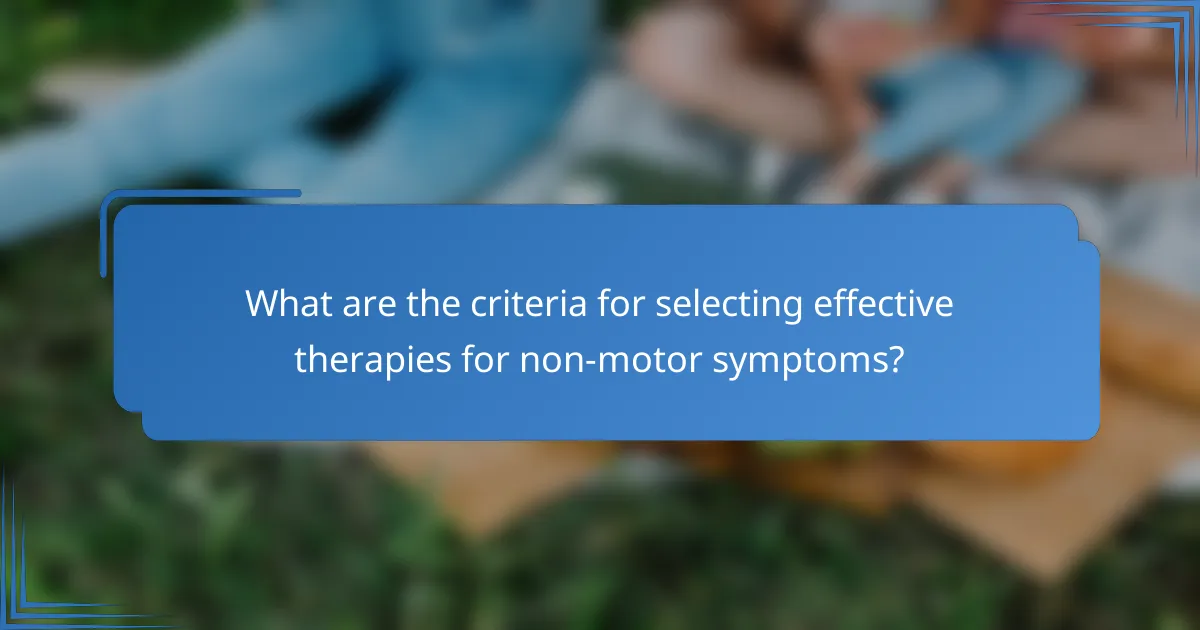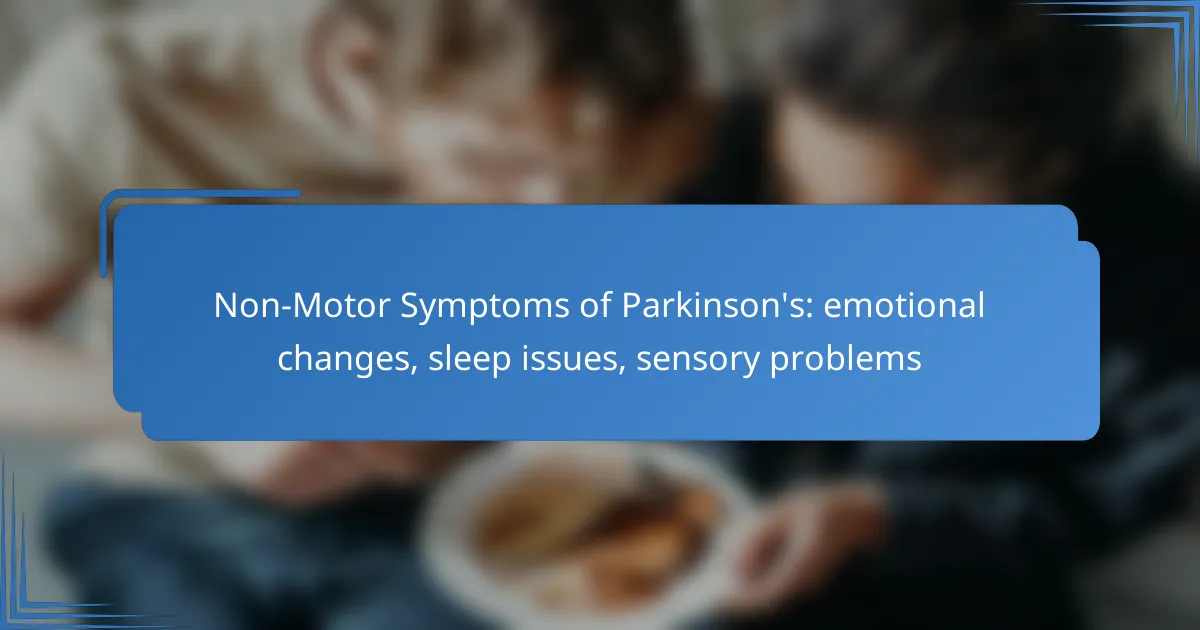Non-motor symptoms of Parkinson’s disease, such as emotional changes, sleep issues, and sensory problems, play a crucial role in the overall experience of those affected. Emotional fluctuations, including increased anxiety and depression, can complicate disease management and diminish quality of life. Additionally, sleep disturbances and sensory alterations, such as changes in smell and touch sensitivity, further challenge daily functioning and well-being. Addressing these symptoms is essential for improving the overall health and comfort of individuals living with Parkinson’s.

What are the emotional changes associated with Parkinson’s in New Zealand?
Emotional changes in individuals with Parkinson’s can significantly impact their quality of life. In New Zealand, these changes often include heightened feelings of depression, anxiety, and fluctuations in mood regulation, which can complicate the management of the disease.
Depression and anxiety
Depression and anxiety are common emotional changes experienced by people with Parkinson’s. Studies suggest that a substantial portion of patients may experience these conditions, with estimates indicating that around 30-50% may face depression at some point. Anxiety often accompanies depression, leading to increased stress and a feeling of being overwhelmed.
It’s crucial for caregivers and healthcare providers to recognize these symptoms early. Treatment options may include therapy, medication, or support groups, which can help mitigate these emotional challenges.
Emotional blunting
Emotional blunting refers to a reduced ability to express or feel emotions, which can occur in Parkinson’s patients. Individuals may find themselves feeling less joy or sadness than they used to, which can affect personal relationships and social interactions. This phenomenon can be distressing for both the individual and their loved ones.
Understanding emotional blunting is essential for caregivers, as it can be mistaken for indifference or lack of interest. Encouraging open communication and providing emotional support can help individuals navigate these changes more effectively.
Changes in mood regulation
Changes in mood regulation are common in Parkinson’s, leading to unpredictable emotional responses. Patients may experience sudden mood swings or heightened irritability, which can be challenging for both the individual and those around them. These fluctuations can be influenced by the progression of the disease and the effectiveness of treatments.
To manage these changes, establishing a routine and incorporating stress-reduction techniques, such as mindfulness or physical activity, can be beneficial. Regular check-ins with healthcare providers can also help in adjusting treatment plans to better support emotional stability.

How can sleep issues be managed for Parkinson’s patients?
Managing sleep issues for Parkinson’s patients involves a combination of lifestyle adjustments, medication, and therapeutic approaches. Effective management can significantly improve sleep quality and overall well-being.
Sleep hygiene practices
Sleep hygiene refers to a set of practices that promote consistent, uninterrupted sleep. For Parkinson’s patients, establishing a regular sleep schedule, creating a comfortable sleep environment, and avoiding stimulants like caffeine in the evening are essential steps.
Additionally, engaging in relaxing activities before bed, such as reading or gentle stretching, can help signal the body that it’s time to wind down. Limiting screen time from devices at least an hour before sleep is also beneficial.
Medications for sleep disturbances
Medications may be prescribed to address specific sleep disturbances in Parkinson’s patients. Common options include melatonin supplements, which can help regulate sleep-wake cycles, and certain antidepressants that have sedative effects.
It’s crucial to consult a healthcare professional before starting any medication, as some drugs may interact with Parkinson’s treatments or exacerbate symptoms. Regular follow-ups can help adjust dosages or switch medications as needed.
Cognitive Behavioral Therapy (CBT)
Cognitive Behavioral Therapy (CBT) is an effective approach for managing sleep issues related to Parkinson’s. CBT focuses on changing negative thought patterns and behaviors that contribute to insomnia.
Therapists may guide patients through techniques such as sleep restriction, stimulus control, and relaxation training. These strategies aim to improve sleep quality by addressing the psychological aspects of sleep disturbances.

What sensory problems do Parkinson’s patients experience?
Parkinson’s patients often face a range of sensory problems that can significantly impact their quality of life. These issues may include altered senses of smell, visual disturbances, and changes in touch sensitivity, which can lead to challenges in daily activities and interactions.
Altered sense of smell
Many individuals with Parkinson’s experience a reduced sense of smell, known as hyposmia, or a complete loss of smell, called anosmia. This alteration can affect their ability to enjoy food and detect hazards, such as smoke or spoiled food. Early detection of this symptom can sometimes aid in diagnosing Parkinson’s disease.
To cope with these changes, patients might consider using other sensory cues, such as texture or temperature, to evaluate food quality. Engaging in activities that stimulate the sense of smell, like cooking with aromatic herbs, may also help maintain olfactory function.
Visual disturbances
Visual disturbances in Parkinson’s patients can manifest as blurred vision, double vision, or difficulty with depth perception. These issues arise due to changes in the brain’s processing of visual information and can lead to increased risk of falls and accidents. Regular eye examinations are crucial to monitor any changes in vision.
Patients may benefit from using brighter lighting at home and avoiding cluttered environments to enhance visual clarity. Occupational therapy can also provide strategies for managing visual challenges in daily tasks.
Touch sensitivity changes
Parkinson’s can lead to altered touch sensitivity, where patients may experience heightened sensitivity or numbness in their extremities. This can affect their ability to perform fine motor tasks, such as buttoning a shirt or holding utensils. Understanding these changes is essential for adapting daily routines.
To manage touch sensitivity, patients should consider using adaptive tools designed for ease of grip and control. Regular hand exercises can also help maintain dexterity and improve overall tactile function.

What products can help alleviate non-motor symptoms of Parkinson’s?
Several products can assist in managing non-motor symptoms of Parkinson’s, including emotional changes, sleep issues, and sensory problems. These tools range from technology-driven solutions to supportive applications designed to enhance well-being.
Wearable sleep trackers
Wearable sleep trackers monitor sleep patterns and provide insights into sleep quality, which can be particularly beneficial for individuals with Parkinson’s experiencing sleep disturbances. These devices typically track metrics such as total sleep time, sleep stages, and disturbances throughout the night.
When choosing a sleep tracker, consider features like heart rate monitoring, app compatibility, and battery life. Popular options include devices from brands like Fitbit and Garmin, which often offer user-friendly interfaces and detailed sleep analysis.
Emotional support apps
Emotional support apps can help individuals with Parkinson’s manage feelings of anxiety and depression, which are common non-motor symptoms. Many of these apps provide resources such as guided meditations, mood tracking, and access to support communities.
Look for apps that offer personalized content and easy navigation. Examples include Headspace for mindfulness and Moodfit for mood tracking. Some apps may also connect users with mental health professionals for additional support.
Adaptive sensory devices
Adaptive sensory devices can enhance the quality of life for those experiencing sensory problems related to Parkinson’s. These devices may include items such as vibrating alarms, tactile feedback tools, or specialized utensils designed to aid in daily activities.
When selecting adaptive sensory devices, consider the specific sensory challenges faced, such as tremors or reduced tactile sensitivity. Products like weighted utensils or sensory fidget tools can provide practical assistance and improve comfort during daily tasks.

What are the criteria for selecting effective therapies for non-motor symptoms?
Effective therapies for non-motor symptoms of Parkinson’s should be tailored to individual needs, supported by clinical evidence, and accessible within the healthcare system. These criteria ensure that treatments address specific challenges faced by patients, are proven to work, and can be easily obtained in their local context.
Patient-specific needs
Understanding patient-specific needs is crucial for selecting therapies for non-motor symptoms. Each individual may experience different emotional changes, sleep issues, or sensory problems, necessitating a personalized approach. For instance, a patient struggling with anxiety may benefit from cognitive behavioral therapy, while another with sleep disturbances might require medication adjustments.
Engaging in open discussions with healthcare providers about symptoms and preferences can help identify the most suitable therapies. Patients should consider factors such as their lifestyle, existing health conditions, and personal goals when evaluating treatment options.
Evidence-based effectiveness
Evidence-based effectiveness refers to the use of therapies that have been scientifically validated to alleviate non-motor symptoms. Treatments should be backed by clinical studies demonstrating their safety and efficacy. For example, certain antidepressants may be effective for managing emotional changes, while specific sleep aids can improve sleep quality.
Patients and caregivers should seek therapies that have strong clinical support, which can often be found in reputable medical guidelines or through consultations with specialists. This ensures that the chosen therapies are not only effective but also align with the latest research findings.
Accessibility in New Zealand
Accessibility in New Zealand is a key factor when selecting therapies for non-motor symptoms. Patients should consider whether treatments are covered by the public healthcare system or require out-of-pocket expenses. Many medications and therapies are available through the Pharmaceutical Management Agency (PHARMAC), which can influence treatment choices.
Additionally, local support services and community resources can enhance accessibility. Patients should explore options such as counseling services, support groups, and educational programs that are available in their region to ensure comprehensive care for non-motor symptoms.
